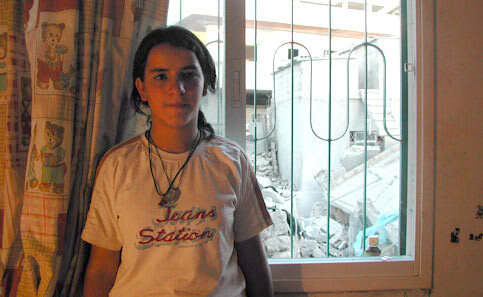Dheisheh refugee camp, Palestine 8 August 2004

Fairuz, Miyasar’s 12-year-old daughter, “They’re taking everything out! What are we going to do about our home?” (Shirabe Yamada)
It has been almost a month since Miyasar’s sleeping pattern has changed. Her back neighbor’s house was dynamited by the Israeli army in the early morning of July 13th in the densely populated West Bank refugee camp of Dheisheh. The rumor has it that the next demolition will be her next door neighbor’s house. Every night, Miyasar lays awake in her bed in the fearful anticipation of the arrival of troops. “I wait until around 2AM to fall a sleep, because if they don’t come until then, we know we are saved for the night,” says the mother of 5 children. Yet her sleeps are shallow, still haunted by the experience and worse to come.
At around 2AM on July 13th, Miyasar, her husband and five teenage children were awoken by the sudden arrival of Israeli soldiers to their home. The troops announced the demolition of their back neighbor’s house, the Safafis, and ordered the family to clear their home while the operation was taking place. Shaken, the family went to their relative’s house across the street, where they stayed until 4AM when the dynamites exploded and jolted awoke the entire camp.
The Safafi home, a typical refugee camp structure built with cinder-blocks and concrete, was flattened, with all walls and windows blown out and a roof bent and collapsed on top of whatever remained. At Miyasar’s house only a bathroom window was shattered, a small miracle thanks to the Safafi’s modest vegetable garden that separated the two houses. Their tomato plants and chicken shed were now buried under debris. The family of nine people, including small children, became homeless.

The flattened Safafi home, a typical refugee camp structure built with cinder-blocks and concrete (Shirabe Yamada)
The Safafi house had been demolished as a collective punishment, for their 18-year-old son Ala had been imprisoned for an alleged involvement with an armed faction. Miyasar’s next door neighbor had two young sons jailed for belonging to the same group. The family, as well as the community, believed that Israelis would come for them next. The following morning, Miyasar’s family sat in daze and shellshock from the horror and lack of sleep, while their next door neighbors were busy taking all their belongings out of the house. The noise kept on floating into Miyasar’s house all day, as adults carried sofas and tables, and small children ran around excitedly with pillows and clothes in their little arms, mistaking the effort to salvage whatever possible to some kind of a game.
“They’re taking everything out! What are we going to do about our home?” Fairuz, Miyasar’s 12-year-old daughter, was nearly in tears, panic-stricken. “Don’t worry. It may be a small damage on that side of our house, but we’ll be fine,” consoled Miyasar. The two houses shared a staircase and a wall in the middle. It was inevitable that the damage would not be as slight as she tried convincing her daughter to be.
Israel has been using the house demolition as a means of collective punishment to families whose member was involved in armed resistance. The policy, illegal by international human rights and humanitarian laws, has made countless families homeless across the occupied territories. Since the Intifada began in 2000, there has been an upsurge of the number of young prisoners, in a direct correlation with the escalation of Israeli occupation policies and resistance against it. There currently are over 8,000 Palestinian prisoners in Israeli jail, approximately 150 from Dheisheh alone, most of whom are teenagers or in their early 20’s. While some are charged in connection with armed attacks against Israel, many prisoners are administratively detained (not convicted of any acts), or jailed for throwing stones at some point in their lives, or for no reasons at all. Tens of thousands of families and neighbors of prisoners are living through the same fear that Miyasar is experiencing. “I can’t stop worrying about my house every minute of the day,” she says, with new dark circles forming around her eyes.
At 1AM on August 5th, less than a month after the Safafi house demolition, Miyasar was still awake in her bed when she heard jeeps and APCs (armored personal carrier) arriving on her street. “Oh my god, they’ve come. It’s over,” she started to cry. Her limbs went limp from fear. The troops passed her house and began operating further down the street on the same block. At around 3AM, the explosion ripped through the night air as the family held on to each other. The home of Helmi Hammash, another prisoner and a relative of Miyaser, had been demolished.
It is hard to predict when and whom the next demolition will strike; some high-profile case houses remain untouched for years, while some homes get destroyed out of blue. Miyasar’s family goes on with routines of life with smiles and jokes and strengths by day, yet there is a constant fear in the back of everyone’s mind. Her daughters only have to look out of their bedroom window to be reminded of the horror. What relief could it be even it wasn’t their next door neighbor this time? Living in a daily fear of losing one’s home is equally as cruel as the demolition itself.
Related Links



